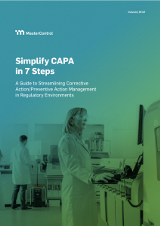Corrective Action (CAPA) Tools
Occasionally, even the best quality management systems will experience deviations and nonconformances. While it is virtually impossible for a company to eliminate adverse events entirely, it is possible to minimize the impact of a deviation or nonconformance, and to prevent it from recurring. This is accomplished by having a solid corrective action and preventive action (CAPA) process in place. Ideally, the process should include the use of robust automated CAPA tools that are part of a comprehensive, close-looped CAPA solution.




